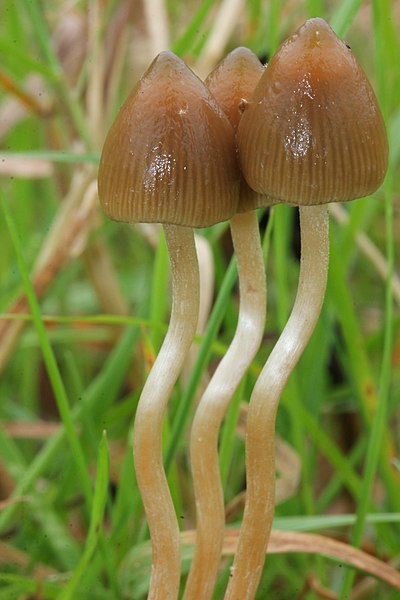A cognitive neuroscience perspective on the interpersonal dimension of psilocybin
Abstract
Psilocybin (O-phosphoryl-4-hydroxy-N,N-dimethyltryptamine) is an indole alkaloid which is present in more than 150 fungi species, some of which are endemic to the UK (e.g., Psilocybe semilanceata). Its molecular structure closely resembles serotonin (5-hydroxytryptamine, 5-HT). In humans, psilocybin is rapidly dephosphorylated to psilocin (4-N,N-dimethyltryptamine) which functions as a non-selective partial 5-HT receptor agonist (it shows particularly high binding affinity for the 5-HT1A and 5-HT2A receptor subtypes; Nichols, 2004). A landmark study conducted at Johns Hopkins University by MacLean, Johnson & Griffiths (2011) experimentally demonstrated that a single high-dose of psilocybin can induce long-lasting personality changes in the domain “Openness to Experience”, as measured by the widely used NEO Personality Inventory. This finding is very intriguing because there is broad scientific consensus that personality traits are relatively stable over time (i.e., a genetic basis is assumed; Bouchard et al., 1990) and can only be altered by major life events (e.g., McCrae & Costa, 1997). Hence, it has been experimentally demonstrated that psilocybin can have profound influences on peoples deeply engrained thinking patterns, emotions, and behaviours. For instance, psilocybin has been very successfully utilised for the treatment of various addictions, major depression and anxiety disorders (for a review see Bogenschutz & Ross, 2016).
Phenomenologically there is a significant degree of similarity between the qualitative experiences induced by psilocybin and those reported by long-term meditators (Griffiths, Richards, Johnson, McCann & Jesse, 2008). Interestingly, the neuronal signature associated with psilocybin shows remarkable overlap with the neuronal activity overserved during mediation (Brewer et al., 2011; cf. Carhart-Harris et al., 2012), i.e., there is convergence between the phenomenology and the neural correlates. Furthermore, mediation has been repeatedly associated with an altruistic orientation (e.g., Wallmark, Safarzadeh, Daukantaitė & Maddux, 2012).
Based on the pertinent literature (e.g., Griffiths, Richards, Johnson, McCann & Jesse, 2008), we argue that psilocybin has the potential to increase empathy and altruistic propensities longitudinally (far beyond the acute psychopharmacological effects) in a dose-dependent manner, in a similar way long-term training in meditation does. Specifically, we theorise that psilocybin can be regarded as an “empathogen” (i.e., empathy and compassion enhancer) with enduring effects on prosocial cognitions and behaviours. We maintain that this increase in empathy is accompanied by an augmentation of general awareness of other people’s emotions (particularly suffering, cf. Preller et al., 2016). Following this line of thought, we predict that psilocybin reduces general stereotyping, prejudices, and discriminatory cognitions and behaviours. We conjecture that the postulated perceptual and attitudinal changes are mediated by the non-dual experience of ego-dissolution (leading to less self-centred cognitions) and the feeling of interconnectedness with others, both of which can be reliably occasioned by psilocybin (but see Barrett & Griffiths, 2017). Furthermore, we propose that specific activity patterns of the anterior insular and posterior cingulate cortices play a pivotal role in this scenario (among several other brain regions associated with the default mode network; see Lebedev et al., 2015). Recent EEG evidence corroborates this hypothesis (e.g., Muthukumaraswamy et al., 2013). In addition, we hypothesise that psilocybin has lasting effects on the modular rich-club architecture of the brain (as quantified by the coefficient Φ), that is, we expect a selective increase in global functional connectivity density which accompanies the perceptual shift of boundaries between the self and others.
References
Barrett, F., & Griffiths, R. (2017). Classic Hallucinogens and Mystical Experiences: Phenomenology and Neural Correlates. Current Topics in Behavioral Neurosciences. http://dx.doi.org/10.1007/7854_2017_474
Bogenschutz, M., & Ross, S. (2016). Therapeutic Applications of Classic Hallucinogens. Current Topics in Behavioral Neurosciences. http://dx.doi.org/10.1007/7854_2016_464
Bouchard, T., Lykken, D., McGue, M., Segal, N., & Tellegen, A. (1990). Sources of human psychological differences: the Minnesota Study of Twins Reared Apart. Science, 250(4978), 223-228. http://dx.doi.org/10.1126/science.2218526
Brewer, J., Worhunsky, P., Gray, J., Tang, Y., Weber, J., & Kober, H. (2011). Meditation experience is associated with differences in default mode network activity and connectivity. Proceedings of The National Academy of Sciences, 108(50), 20254-20259. http://dx.doi.org/10.1073/pnas.1112029108
Carhart-Harris, R., Erritzoe, D., Williams, T., Stone, J., Reed, L., & Colasanti, A. et al. (2012). Neural correlates of the psychedelic state as determined by fMRI studies with psilocybin. Proceedings of The National Academy of Sciences, 109(6), 2138-2143. http://dx.doi.org/10.1073/pnas.1119598109
Garcia-Romeu, A., Griffiths, R., & Johnson, M. (2015). Psilocybin-Occasioned Mystical Experiences in the Treatment of Tobacco Addiction. Current Drug Abuse Reviews, 7(3), 157-164. http://dx.doi.org/10.2174/1874473708666150107121331
Griffiths, R., Richards, W., Johnson, M., McCann, U., & Jesse, R. (2008). Mystical-type experiences occasioned by psilocybin mediate the attribution of personal meaning and spiritual significance 14 months later. Journal of Psychopharmacology, 22(6), 621-632. http://dx.doi.org/10.1177/0269881108094300
Lebedev, A., Lövdén, M., Rosenthal, G., Feilding, A., Nutt, D., & Carhart-Harris, R. (2015). Finding the self by losing the self: Neural correlates of ego-dissolution under psilocybin. Human Brain Mapping, 36(8), 3137-3153. http://dx.doi.org/10.1002/hbm.22833
MacLean, K., Johnson, M., & Griffiths, R. (2011). Mystical experiences occasioned by the hallucinogen psilocybin lead to increases in the personality domain of openness. Journal of Psychopharmacology, 25(11), 1453-1461. http://dx.doi.org/10.1177/0269881111420188
McCrae, R., & Costa, P. (1997). Personality trait structure as a human universal. American Psychologist, 52(5), 509-516. http://dx.doi.org/10.1037//0003-066x.52.5.509
Muthukumaraswamy, S., Carhart-Harris, R., Moran, R., Brookes, M., Williams, T., & Errtizoe, D. et al. (2013). Broadband Cortical Desynchronization Underlies the Human Psychedelic State. Journal Of Neuroscience, 33(38), 15171-15183. http://dx.doi.org/10.1523/jneurosci.2063-13.2013
Nichols, D. (2004). Hallucinogens. Pharmacology & Therapeutics, 101(2), 131-181. http://dx.doi.org/10.1016/j.pharmthera.2003.11.002
Preller, K., Pokorny, T., Hock, A., Kraehenmann, R., Stämpfli, P., & Seifritz, E. et al. (2016). Effects of serotonin 2A/1A receptor stimulation on social exclusion processing. Proceedings of The National Academy Of Sciences, 113(18), 5119-5124. http://dx.doi.org/10.1073/pnas.1524187113
Tófoli, L., & de Araujo, D. (2016). Treating Addiction. International Review Of Neurobiology, 157-185. http://dx.doi.org/10.1016/bs.irn.2016.06.005
Wallmark, E., Safarzadeh, K., Daukantaitė, D., & Maddux, R. (2012). Promoting Altruism Through Meditation: An 8-Week Randomized Controlled Pilot Study. Mindfulness, 4(3), 223-234. http://dx.doi.org/10.1007/s12671-012-0115-4





Das sind nützliche Informationen, ich lese Ihren Blog immer gerne. David, Autor des Blogs https://riewes.de